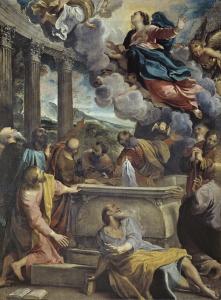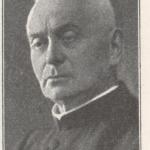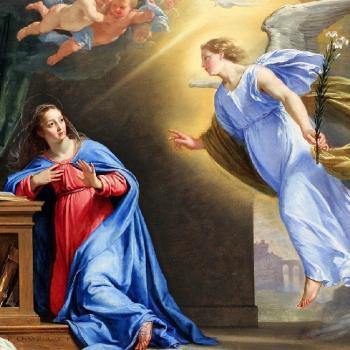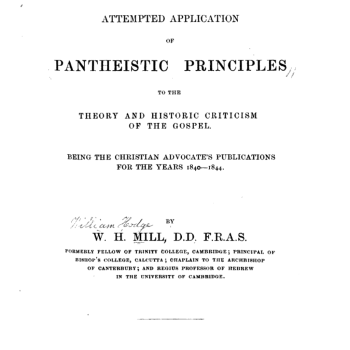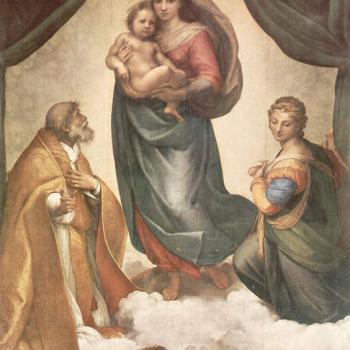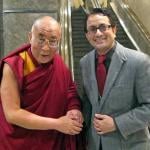James Swan is an anti-Catholic Reformed Protestant apologist, who runs the Boors All blog. In his article dated 10 October 2011 and entitled, “Is There a Professional Roman Catholic Apologist in the House?,” he demonstrated the oft-observed profound ignorance of anti-Catholic critics of Catholic beliefs. He simply doesn’t understand how Catholic magisterial authority and infallibility work. His words will be in blue.
***
Over on Dr. Gene Veith’s blog I was politely challenged on my assumptions about the Assumption. Since I’m not a professional Roman Catholic apologist, I’m not able to interpret Romanism infallibly.
Certainly not, but be that as it may, I think he is duty-bound as a supposedly eminent researcher and critic of Catholicism, to interpret Catholicism honestly and intelligently and to obtain, at the very least, a basic, rudimentary knowledge of the topic that he chooses to write about for public consumption (deigning to properly educate his readers). He has done neither in this article. As I have noted many times, in any middle school debate team, the first thing learned is that the wise and able debater must know his opponent’s view at least as well as they do themselves, if not even more so.
Perhaps though, some of you can.
I don’t claim to have infallible interpretation, but that’s not necessary, and it is the Catholic magisterium’s function, not mine. What I do claim is to understand the basic distinctions that Catholics make in terms of degrees of authority of documents and doctrines. The myth that every Catholic layman must be able to possess infallible interpretation, lest Catholicism collapse in a heap from internal contradiction, has been disposed of in several of my articles:
Dialogue on the Logic of Catholic Infallible Authority [6-4-96]
Church Authority & Certainty (The “Infallibility Regress”) [July 2000; some revisions on 12-8-11]
Ecclesiological Certainty (?) & the “Infallibility Regress” [5-22-03 and 10-7-08]
Does Church Infallibility Require Infallible Catholics? [6-8-10]
Shelly: Catholics do believe Mary could and did die, then she was taken up bodily into Heaven. . . .
Some Catholics (the majority, including myself) believe that she died, and some believe that she didn’t. Both views are fully permissible, as I will further explain below.
As I’ve understood Romanism, it isn’t determined one way or the other that Mary died. A Roman Catholic is free to believe either. This is some of what Roman Catholics are required to believe about Mary’s assumption:
“…We pronounce, declare, and define it to be a divinely revealed dogma: that the Immaculate Mother of God, the ever Virgin Mary, having completed the course of her earthly life, was assumed body and soul into heavenly glory.
Hence, if anyone, which God forbid, should dare willfully to deny or call into doubt that which we have defined, let him know that he has fallen away completely from the divine and Catholic faith…It is forbidden to any man to change this, Our declaration, pronouncement, and definition or, by rash attempt, to oppose and counter it. If any man should presume to make such an attempt, let him know that he will incur the wrath of Almighty God and of the Blessed Apostles Peter and Paul.” [decree Munificentissimus Deus by Pope Pius XII; my italics; the date of this decree was 1 November 1950]
Here, Swan actually accurately understands the reality of Catholic belief (particularly regarding Mary’s Assumption). He should have quit while he was ahead, rather than go on to try in vain to establish alleged internal Catholic incoherence and contradiction. It’s one of a million examples of anti-Catholics ludicrously believing themselves to be better informed about Catholicism than Catholic theologians and apologists are, and attempting to ridiculously lecture us out of their blissful ignorance. Read on, and you’ll see a classic example of this pitiful methodology.
It seems to me that early church history didn’t know what to do about the death of Mary. For instance, the words of Epiphanius contradict the idea of a long held belief in the Assumption. Epiphanius notes another “tradition” that no one knows what happened to Mary. His is the earliest non-heretical voice that comments on the subject of Mary’s bodily assumption, around 377:
“But if some think us mistaken, let them search the Scriptures. They will not find Mary’s death; they will not find whether she died or did not die; they will not find whether she was buried or was not buried … Scripture is absolutely silent (on the end of Mary) … For my own part, I do not dare to speak, but I keep my own thoughts and I practice silence … The fact is, Scripture has outstripped the human mind and left uncertain … Did she die, we do not know … Either the holy Virgin died and was buried … Or she was killed … Or she remained alive, since nothing is impossible with God and He can do whatever He desires; for her end no-one knows.’” (Epiphanius, Panarion, Haer. 78.10-11, 23. Cited by Juniper Carol, O.F.M. ed., Mariology, Vol. II (Milwaukee: Bruce, 1957), pp. 139-40).”
Taking an agnostic view — especially because Scripture does — is not the same thing as not knowing “what to do about” something. It’s simply being intellectually honest in light of what is known and what is not known. Secondly, Epiphanius’ words do not contradict the belief in the Assumption of Mary in the least, since he is not addressing that (at least not in what Swan cites, with no less than seven ellipses (“…”). He was commenting on the question of whether she died or not, which is a completely separate question, not affecting belief in her Bodily Assumption. He thinks either scenario is possible: that she “died” or that she “remained alive” and did not undergo death (similar to Enoch and Elijah). Lawrence P. Everett, C.Ss.R., S.T.D., in his work, Mariology (Bruce Publishing Co., 1957, 461-492), observed:
In the first three centuries there are absolutely no references in the authentic works of the Fathers or ecclesiastical writers to the death or bodily immortality of Mary. Nor is there any mention of a tomb of Mary in the first centuries of Christianity. The veneration of the tomb of the Blessed Virgin at Jerusalem began about the middle of the fifth century; and even here there is no agreement as to whether its locality was in the Garden of Olives or in the Valley of Josaphat. . . . no early writer ever doubted the fact of her death. They did not, however, examine the question; they merely took the fact of her death for granted.
That doesn’t sound to me like Christians in the first three centuries “didn’t know what to do about the death of Mary.” They either didn’t think about it, or “took the fact of her death for granted.” Epiphanius had the insight of believing that either thing was possible: a death, or God taking Mary without death (which is what Catholics are still allowed to speculate about today). But the early tradition strongly tended towards what most Catholics believe: that she died, as her Son did.
Giovanni Miegge, The Virgin Mary (Philadelphia: Westminster Press, 1955), states:
“Actually the good Epiphanius made a superfluous display of hypotheses. If in his time no tradition existed about the end of Mary’s life, that is simply due to the fact that her death happened in a time when the practice of venerating the memory of martyrs or of persons eminent in the Church had not yet arisen, and it passed unobserved.” (page 85)
I think this is a dubious assertion at best. After all, Christians already believed in extraordinary non-death departures from this life in the case of Enoch (Heb 11:5; cf. Gen 5:24), Elijah (2 Ki 2:1,11), and many during the Second Coming (1 Thess 4:15-17), and also similar dramatic “going-up-to-heaven” events after having died, in the case of the two witnesses of Revelation (11:7-12) and our Lord Jesus Himself. And we have St. Paul reporting that he went up to heaven before he died (2 Cor 12:1-4): possibly in his body; possibly not (12:3), and St. John also seems to be in heaven witnessing many things (the entire book of Revelation). That’s seven biblical analogies to Mary’s Assumption, to one degree or another!
Thus there is a long scriptural history of very similar things, so that this hypothesis regarding veneration is not the only possible explanation at all. Christians simply didn’t think about it much at first: as was the case with many doctrines that developed slowly, but the above explicit scriptural parallels were perhaps what precipitated greater and more rapid development. Mariology in general is a prime example of that (because Christology and trinitarianism was more important). But it’s not alone in this respect; the same applied to many beliefs that Catholics and Protestants hold in common.
On the other hand, if pressed- I would be forced to conclude there is no “one” tradition of the assumption- there doesn’t appear to be any one unified theme or tradition.
Again, this confuses to some extent the difference between Mary’s Assumption and whether she died. They are two different things, and continued to be distinguished in the 1950 dogmatic definition.
The only certain thing that tradition appears to point to in this matter, is that no one knows what happened to Mary.
No one figured out that all 27 NT books were indeed scriptural and canonical, either, until St. Athanasius in 367: more than 330 years after the death of Christ, or roughly the same amount of time as Bach’s birth — 1685 — till now. So no biggie; ho hum. Just another instance of dozens of development of doctrine . . . Since Swan has only a very dim understanding of development, he thinks this is an issue or a “difficulty”, when in fact it is not at all.
Second, Mary’s role in the New Testament diminishes- what I mean is this- The gospel accounts contain material about Mary- Acts and the rest of the New Testament do not record her “doings” in the early church. In other words, in the Bible she fades from the scene, . . .
Yes, of course she does, because she is the humble handmaiden of the Lord, and because her Son had to be front and center at first. Once that was established, then Christians pondered her sublime role much more deeply. Catholics believe that Christians continue to learn things to this day. We’re not theologically and intellectually stagnant. But it’s all consistent developments from the apostolic deposit. Nothing new or novel . . . that was left for the Protestant Revolution to introduce.
Shelly: Actually, it is an obligation for Catholics to believe that Mary died, then was assumed into Heaven.
It’s not at all. Shelly is wrong, and even Swan pointed out why: when the Assumption was defined as obligatory dogma, the question of whether she died or not was left as an open question; i.e., Catholics were free to hold different opinions.
This certitude that Mary in fact died and was believed by the Roman Catholic Church to have died before her bodily assumption is nicely addressed by Pope Pius XII when he states in section 17 of Munificantissimu Deus (MD–see link in my original posting above) in quoting an historical source that “…Adrian I, our predecessor of immortal memory, sent to the Emperor Charlemagne. These words are found in this volume: “Venerable to us, O Lord, is the festivity of this day on which the holy Mother of God suffered temporal death, but still could not be kept down by the bonds of death, who has begotten your Son our Lord incarnate from herself.”
Yes, it is a strong tradition and continues to be the majority view today, but that’s not the same as proclaiming that it is obligatory. Catholicism has strong competing views about predestination, too, and both are allowed to be held (I’m a Molinist / Congruist). The earlier pope simply held this opinion. It doesn’t follow that all must. His opinion is not listed in Denzinger: the compendium of Catholic dogmas.
Well, we’ll have to let a professional Roman Catholic apologist solve this riddle.
There is no “riddle” in the first place! Pope Pius XII just happened to mention some instances of the “Mary died” tradition. He probably accepted it himself, but this is different from it being required of all Catholics. And we know that because when he wrote the dogmatic definition it was not part of it. None of this is in the least bit inconsistent or a problem.
I’ve read quite a number of sources (Protestant and Roman Catholic) saying that it is not essential for a Roman Catholic to believe Mary died.
And they are correct. So why doesn’t Swan accept their word? Answer: because he despises them as intellectually dishonest buffoons. His treatment of me these past 22 years is instructive. Swan cites Catholics Karl Keating, Patrick Madrid, and myself. He quotes one of my apologetics inserts from The New Catholic Answer Bible: “If indeed she was free from sin, then it follows that she would not have to undergo the decay of death, which was the penalty for sin.”
But of course that portion is not addressing the question of whether she died, but rather, whether she underwent bodily decay (which has to do with the nature of the Assumption itself). Thus Swan doesn’t even know which portion to cite, so as to prove what he is trying to prove. In other writings of mine written before Swan’s article in question, I reiterated that Catholics can believe either that she died, or did not die (examples: “Catholics have not made it a matter of dogma that Mary died. She may have, or may not have, . . .” [9-24-06] “the Church has not declared whether Mary died or not” [9-4-08] ). My blog has always had easy search functions, or else Google Advanced Search can handily locate materials as well.
I could multiply these sources as well. These were only a few. Whatever the answer, this very issue demonstrates a fatal flaw in Romanism: even their alleged infallible dogmatic pronouncements are open to interpretation.
Of course, he has demonstrated no such thing — certainly not regarding the Assumption — , as I have proven above. The problem resides in the hostility to Catholicism, illogical thinking, and fact-challenged false assumptions (no pun intended) and premises in his own head.
*
***
*
Practical Matters: Perhaps some of my 4,600+ free online articles (the most comprehensive “one-stop” Catholic apologetics site) or fifty-five books have helped you (by God’s grace) to decide to become Catholic or to return to the Church, or better understand some doctrines and why we believe them.
Or you may believe my work is worthy to support for the purpose of apologetics and evangelism in general. If so, please seriously consider a much-needed financial contribution. I’m always in need of more funds: especially monthly support. “The laborer is worthy of his wages” (1 Tim 5:18, NKJV). 1 December 2021 was my 20th anniversary as a full-time Catholic apologist, and February 2022 marked the 25th anniversary of my blog.
PayPal donations are the easiest: just send to my email address: [email protected]. Here’s also a second page to get to PayPal. You’ll see the term “Catholic Used Book Service”, which is my old side-business. To learn about the different methods of contributing (including Zelle), see my page: About Catholic Apologist Dave Armstrong / Donation Information. Thanks a million from the bottom of my heart!
*
***
*
Photo credit: Assumption of Mary (c. 1590), by Annibale Carracci (1560-1609) [public domain / Wikimedia Commons]
Summary: Anti-Catholic zealot James Swan tries in vain to establish an inconsistency in Catholic opinions as to whether the Blessed Virgin Mary died prior to her Assumption.


